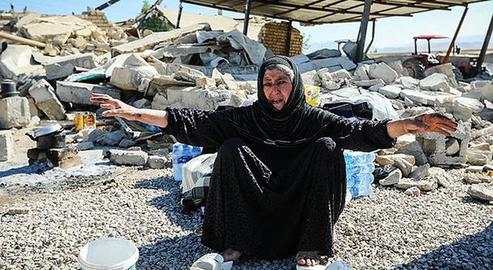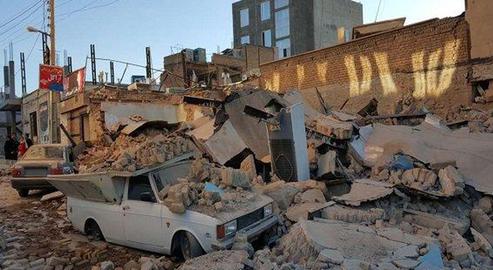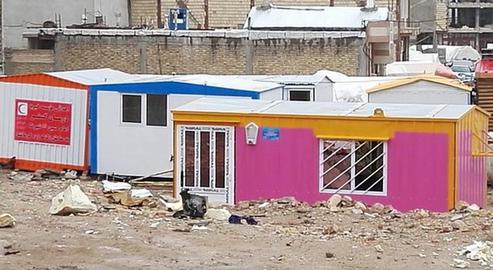Three years have passed since a 7.3 magnitude earthquake struck the western Iranian province of Kermanshah, killing 600 people and injuring 10,000 more, and devastating countless lives and livelihoods in the process. More than 200 suicides were registered in the province that year: an increase on the year before, and one that some analysts attributed to socio-economic stress brought on by the quake.
Now in 2020, communities up and down the province continue to feel the aftershocks of the disaster - chiefly in the form of widespread homelessness and the ensuing psychological strain. According of official statistics, some 104,356 residential units in Kermanshah were either damaged or destroyed during the quake. One month later in March 2017, President Hassan Rouhani promised to rebuild or replace all the affected homes by summer 2018 at the latest. This has not happened.
Tenants in informal or rented accommodation, who did not own a home to be rebuilt, make up the majority of the post-earthquake homeless population in Kermanshah. Official figures indicate that at least 3,600 households were tenants at the time of the incident – unofficially, the true figure is thought to be closer to 5,000.
Last year the Iranian government destroyed a number of shipping container homes and ramshackle dwellings where homeless tenants in Kermanshah had been living , to make way for the Arabaeen caravan. For the time being at least, the luckiest of the former tenants will continue to stay with friends and relatives in Kermanshah. The rest, though, must endure living in tents, informal barracks and shantytowns. Promised land and loans that never materialized, they remain exposed to the elements, and both infectious diseases and frostbite have blighted the lives of hundreds in the past three years.
Worse still, some of these people have been made homeless twice over. During the Arbaeen parades in 2019, IranWire has learned, agents from the municipality tore down their makeshift shelters and shipping container homes.
A civil rights campaigner based in Sarpol-e Zahab, a county of Kermanshah close to the Iraqi border where some of the sabotage took place, told IranWire: "The crisis of homeless tenants in Kermanshah province has become just another one of the crises hidden under the skin of the city. Citizens who remained with their relatives, or in garages and pocket homes, still have no shelter today.
“The earthquake destroyed about 60 percent of the city of Sarpol-e Zahab. The remaining 40 percent of the houses had to be divided among a huge tenant population. Our main complaint is that instead of finding permanent shelters for these tenants, the government gave them cash.”
In the aftermath of the disaster, Kermanshah Governor's office gave 15 million tomans [US $3,500] in grants to each homeless tenant with which to find a new place to live. But, the activist points out, “in our city, where house prices are very high, you can’t build so much as a shed with that kind of money.”
Those made homeless by the earthquake who had owned their own house or land received a 40 to 50 million [$9,500 to $11,875] grant toward building a new home, which in Kermanshah is also woefully inadequate. This grant was also paid in instalments during the different phases of construction, which meant that some were able to build the foundations of their replacement houses but could not afford the rest. Many of these people are now making do in the shells of half-built houses.
Sarpol-e Zahab: A Case Study in Post-Disaster Neglect
In the city of Sarpol-e Zahab, about 50 percent of 90,000-strong population was living in rented accommodation at the time of the quake. Not only were most of these people left without a place to live, but the destruction of commercial premises and infrastructure meant that many were also without a job.
Unemployment and financial strain are thought to be part of the reason for the increase in suicide attempts in Kermanshah in 2017. Struggling to afford even basic household items, let alone a secure and warm place to live and from which to rebuild their lives, these tenants – many of whom are shackled by debts that predate the earthquake – have been driven to desperation.
In Sarpol-e Zahab, one provincial official reported 100 suicides in the city within the first few months of the quake. Among the reported cases across Kermanshah were two teenage girls who died within days of each other in July 2018: 17-year-old Maryam Rostami, from the village of Zafaran in Sarpol-e Zahab, who killed herself by taking rice pills, and her cousin Nooshin Rostami, 16, from the district of Qalkhani, who reportedly turned a gun on herself.
The civil rights activist told IranWire: “These two girls had planned to commit suicide along with six other relatives in Salas Babajani County, but their parents had prevented them from doing so. At the same time, a brother and a sister aged 12 have killed themselves: one by taking poison and another by taking a lot of pills. The families of all these young people lived in shipping container homes.
“Elsewhere, a teacher in Kermanshah province committed suicide, according to his family, because he was suffering so badly due to the suicides of a large number of his students. There was also an 80-year-old man, known as Shah Mar Buchani, who killed himself. One of the last things he said to his children before he died was ‘I cannot bear to start from scratch’.”
Related coverage:
visit the accountability section
In this section of Iran Wire, you can contact the officials and launch your campaign for various problems



























comments